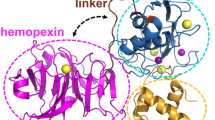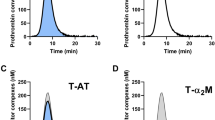Abstract
THE availability of a large number of inhibitors of proteolytic enzymes, as well as the availability of highly purified streptokinase, plasminogen and plasmin, suggested to me the investigation of the nature of the enzyme or enzymes capable of dissolving fibrin clots. Proteolytic enzymes in general, but more particularly trypsin and chymotrypsin, are known for their ability to digest fibrin clots; certain snake venoms can also do this. The proteolysis of fibrinogen and fibrin by venoms, trypsin or plasmin appears to vary, depending upon which of the enzyme is used. The clotting of fibrinogen is the result of the splitting of an arginine peptide bond in the fibrinogen molecule1; this tends to produce a product (fibrin) which is much less susceptible to hydrolysis by trypsin and venoms than the parent substance, fibrinogen2,3. Fibrin, on the other hand, is as sensitive to plasmin as is fibrinogen3.
This is a preview of subscription content, access via your institution
Access options
Subscribe to this journal
Receive 51 print issues and online access
$199.00 per year
only $3.90 per issue
Buy this article
- Purchase on Springer Link
- Instant access to full article PDF
Prices may be subject to local taxes which are calculated during checkout
Similar content being viewed by others
References
Lorand, L., and Middlebrook, W. R., Biochem. J., 52, 196 (1952).
Deutsch, H. F., and Dinez, C. R., J. Biol. Chem., 216, 17 (1955).
Sarkar, N. K., and Devi, Anima, Proc. of Seventh Int. Congr. on Hæmat. (1958).
Laki, K., Arch. Biochem. Biophys., 32, 317 (1951).
Anson, M. L., J. Gen. Physiol., 22, 79 (1938).
Troll, W., Sherry, S., and Wachman, J., J. Biol. Chem., 208, 85 (1954).
Grey, J. B., and Sarkar, N. K. (unpublished work).
Johnson, A. J., McCarty, W. R., and Tillet, W. S., Surgical Forum, 9, 252 (1958).
Author information
Authors and Affiliations
Rights and permissions
About this article
Cite this article
SARKAR, N. Mechanism of Clot Lysis. Nature 185, 624–625 (1960). https://doi.org/10.1038/185624a0
Issue Date:
DOI: https://doi.org/10.1038/185624a0
This article is cited by
-
Plasmin determination based on rate of lysis of fibrin gel
Bulletin of Experimental Biology and Medicine (1989)
-
Reduced Fibrinolytic Activity of Atherosclerotic Sera caused by an Increase in Low-density Lipoproteins in Blood
Nature (1961)
Comments
By submitting a comment you agree to abide by our Terms and Community Guidelines. If you find something abusive or that does not comply with our terms or guidelines please flag it as inappropriate.



